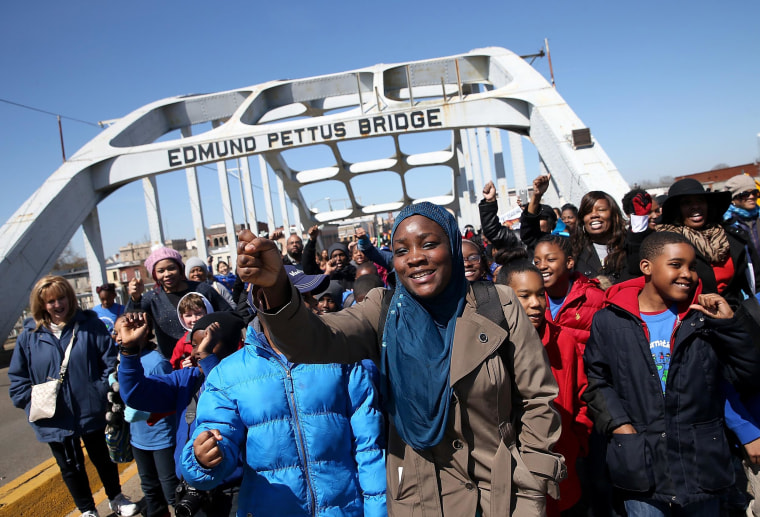As civil rights foot soldiers like Rep. John Lewis, D-Ga., returned to Selma to commemorate the 50th anniversary of “Bloody Sunday,” they carried a message for young people with them as well: There is unfinished business.
Fifty years ago, peaceful protesters attempting to cross the Edmund Pettus Bridge were met with the clubs, rods and horses’ hooves of white Alabamian State Troopers. It was a brutal scene: Heads were cracked against the pavement while tear gas gushed and engulfed the bridge, stinging the eyes of those who marched.
Fifty years later, thousands across the nation made their way back to reflect on the historic Civil Rights moment and it’s critical role in securing the Voting Rights Act of 1965, which guaranteed voting rights for African-Americans. While there were no clubs, rods or horses’ hooves this time, the sale of black shirts and hoodies reading “I Can’t Breathe” are reminders of how much more change needs to be made.
“We have to stop looking at things as fads and trends and hashtags on Twitter and social media and we have to do the paperwork behind it like the NAACP did. You can post, but what else are you going to do to back up that post?”
In 2015, young people are still living in a reality where shirts and hoodies like these even exist. It is this context that allows for an intimate engagement with the traumas of Bloody Sunday.
“We’re still fighting the same values of the black life in America,” Amber Clark, a junior at Alabama State University said. “The nooses were replaced with bullets. It went from wearing a hood to wearing a badge. Now, every 28 hours, we face the police or vigilante having the ability to shoot one of our black men and our black women.”
Clark, who is originally from Atlanta, Georgia — another landmark city of the civil rights movement — said being in Selma is a “reawakening” to her history as a black woman. She said young people should be using their voices to set a new trajectory for Black America.
After listening to the messages of civil rights activists this weekend, young people are starting to speak back. In fact most of them — as young as 16 — intend on carrying the torch of fighting for civil rights, which the former foot soldiers now passed to them.
“We have to take these situations and learn from people who have done things in the past to be able to move forward in the future,” Sparkman High School senior Briann Ryce said. “We have to look at these things and recreate them and turn them into things that represent our time.”
Ryce, who plans to attend Tuskegee University in the Fall to pursue a career in Marketing, said the commemoration confirmed her decision to attend a Historically Black College. She believes it will provide another means for keeping her history alive and contributing to the progression of the civil rights movement.
During the commemorative weekend, Samuel Gideon, a junior at Sparkman High, had the opportunity to meet a number of people who marched five decades ago. “To be able to shake their hand, and tell them thank you is amazing,” he said.
A sophomore at Sparkman, Jaida Steele echoed similar sentiments of gratitude. “Somebody risked their life so you can have a better life,” she said. “How do you repay somebody for that?”
In addition to saying “thank you” to the men and women who put their lives and allegiances on the line for justice, others believe they can show their gratitude by continuing the movement.
Thousands of college students and young people traveled to Selma, further lending their voices to advocate for social justice and civil rights. Camryn Johnson of Atlanta said the commemoration "shows the progress that we've made but also the progress that we have to make, to make America more equal for everybody."
“We’re still fighting the same values of the black life in America... The nooses were replaced with bullets."
Amanda Price from Alabama State University said that as a member of the student government association, it is her duty, cause and purpose to be in Selma. "Without young people, there would never be a movement, there would never be a revolution. It is always led and all the fire and all the passion always comes from the youth."
"With experiences like this, young people can take the lessons learned from all of the people who are demonstrating today and apply it to the voting process," said Kwan Boyd, a student at Columbus State University in Columbus, Georgia. "This would be a perfect opportunity for young students, young people to become more informed, to become more aware of the difficulties that people had to go through in order to receive those rights," Boyd said.

The movement does not look the way it did some fifty years ago. With advancements and accessibilities in technology paving the way for “cyber activism,” there are now a variety of mediums people are using to speak out. But some are not convinced that this is enough.
“We have to stop looking at things as fads and trends and hashtags on Twitter and Social media and we have to do the paperwork behind it like the NAACP did,” Anastacia Davis, a sophomore at ASU, said. “You can post, but what else are you going to do to back up that post?”
Davis said young people need to keep the movement moving forward to preserve the legacies of resistance while making new contributions to a better world.
"We are known as Generation Y,” she said. “We determine what our future is going to be.”